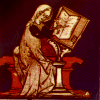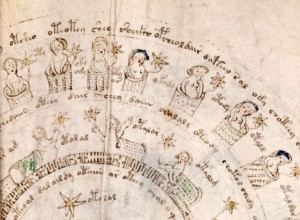
I blogged about the Voynich Manuscript quite a while ago, and since then I’ve read a few more books on the subject in my spare time(1). Yesterday, I watched a new documentary about the Voynich Manuscript called the “The Voynich Manuscript – The World’s Most Mysterious Manuscript” which addressed its age and speculated as to its author. The conclusion of the documentary was that it was written over the course of a couple of days in the 1420s(2), somewhere in a northern Italian city that had a fort with swallow (or dove) tail battlements. It also claimed that the intent matters, and that it’s possible that the manuscript text is gibberish while the images or not.
To me, this text screams “alchemy” for a few reasons, but not necessarily from a scientific perspective. Alchemy was (and continues to be) a blend of the metaphorical and chemical. Images, codes, symbols, and gibberish (which is thought to originate from the Islamic alchemist Jabir ibn Hayyan) were used to explore transmutation and the relationship between the masculine and the feminine. A pregnant woman, for example, was commonly used to represent the moon. So an image that “looks like” a series of pregnant women taking a bath, would (through the lens of alchemy) be the phases of the moon. Their modesty protected, would be apropros of the 15th century–especially if the book was, indeed, written in Italy which was heavily influenced by the mores of the Holy Roman Empire and Catholicism.

Timing, in occult terms, was very important to the success of any rite and, for alchemy, the Master Work in order to successfully perform a transmutation that was both physical and metaphysical. While the Master Work itself varied, key principles were often explored between alchemist and pupil or couples such as Nicholas Flamel (Yep, the Harry Potter character was based on him) and his wife Perenelle. Often, in history, women are overlooked and, in this case, I have yet to read a discussion about the aspects of gender in this work which, I feel, are hugely important given the role of gender in alchemic symbology. Hermaphroditic characters, for example, were also used to portray the perfect union between the masculine and the feminine or, as is usually the case, Hermes/Mercury.
The fact that so many plants were illustrated in the Voynich Manuscript is a different way of portraying that union, with the plant and its “seeds” being the fruits of an experiment when the Sun (male/heat/sunshine) and Moon (female/cool/water) shines down on the earth. Even so, the images would be based on an amalgamation of what the scribe knew or, in my mind, what that person was taught. Alchemists usually come in pairs, and are performing works that would be construed as heresy and grounds for trial and accusation of witchcraft. While the nobility and wealthy class might somewhat be immune to such claims, they would protect what is known as “The Golden Chain” at all costs. The Golden Chain is the handing down of knowledge from master to scribe and so on throughout the centuries.
In my mind, the text could be a combination of gibberish and code. Remove the gibberish, which is known only to the scribe, and the code emerges. I believe this is not the only text that was written at the time, and the book was either intended to be passed down to the next scribe, or was written in exchange for a large sum of money. The folios themselves might even have been bound or collected at a later date. After all, if you are teaching occult knowledge you wish to keep hidden from an Inquisitor, from the scrutiny of the Church, from rivals and greedy nobles who desire what you know–why just write one text if you intend to pass it on?(3) Or, alternatively, if you were paid to write alchemical knowledge by a wealthy noble, why bother worrying about whether or not you were telling the truth? You could generate something that looks like the real thing, without revealing what you actually know?
Regardless, one of the things I find interesting about the Voynich Manuscript(4) is the fact that every theory I’ve heard “seems” to be true. I am not certain we’ll ever find proof, but I do feel that the intent–the reason why these folios were produced in the first place–would provide some answers.
(1) I tend to read non-fiction before drifting off to sleep. It allows me to clear my head so I can dream about my plots and characters interruption-free. I tend to read fiction in a sitting for this reason, or listen to audio books.
(2) Interestingly, 1420 was a leap year which might have had significance in terms of occult timing as well.
(3) Several countries outlawed alchemy late 14th century/early 15th century due to the obsession with turning lead into gold. There’s an interesting book you can read titled: “Alchemy and Authority in the Holy Roman Empire.”
(4) Hey, some people are obsessed with aliens. Me? I like a good historical mystery to chew on every once in a while.
- Mood: Is my nerdness showing yet?
Caffeinated Beverages Consumed: Not. Enough.
Work-Out Minutes Logged Yesterday: 30. Day 8 in a row!
In My Ears: Listening to the tail end of a so-so comedy hour.
Game Last Played: Plants vs. Zombies I
Book Last Read: Raising Steam by Terry Pratchett
Movie/TV Show Last Viewed: Empire Strikes Back.
Latest Artistic Project: Um… Let me get right on that.
Latest Fiction/Comic Release: Gods, Memes, and Monsters
Latest Game Release: Dread Names, Red List for Vampire: the Masquerade and Ghosts in the Black for the Firefly RPG.
Current State of Projects: Read my latest project update and My Departure from the Conan RPG.
